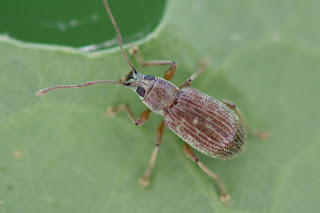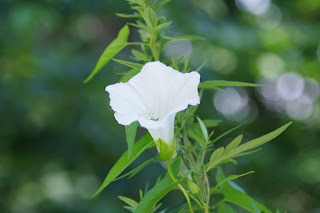Back on the subject of hearing insects in the summer, today I heard the first cicada of the year. I rarely see cicadas, but I hear them every year. They make an unlovely sound, but hearing it makes it feel like summer.
Backyard Bug of the Day:
This amazing little moth is only about half an inch long, if that. You can see that it is on the window screen of my house–my husband gets the credit for spotting this one this afternoon. I came home from an appointment and he said he had something to show me, and this was it. It spent several hours in that spot.
This was not in my book, so I don't know what kind of moth it is. It is a new one for me. Edit: A friend saw my pictures of this moth and knew it was a smaller parasa moth. I have seen smaller parasa caterpillars in my yard before (not this year, though), so now I have seen both stages for this Lepidoptera.
Other Bugs:
The Backyard Bug of the Day was to one side of the back door, and this little moth was to the other. This one is even smaller.
Here's something I enjoy highlighting when I get the chance–three stages of the life cycle of an insect, all in one day. I give you Twenty Spotted Lady Beetle, Larva, to Pupa, to Imago:
Larva
Pupa:
Imago, or adult. I found all of these on the same dogwood tree, where obviously at some point a lot of lady beetle eggs were laid, and those eggs hatched, and the larvae that emerged have gone through their life cycle on the leaves of the tree. (Strange to note that I have not seen any aphids on the tree, which are the primary food source of lady beetle larvae). For a while I was seeing a lot of larvae, and now there are not so many, but the presence of pupae and imagos explains why. Given what some of the imagos have been up to there are probably more eggs on the tree somewhere, but I was not able to find them. I would also like to note that this is a really small species of lady beetle. Not what you're used to in the bright red "ladybugs" everyone knows and recognizes.
I also found this on one of the leaves, and at first I thought that it might be a recently hatched twenty spotted lady beetle larva, because it has the coloring, but that is not what recently hatched lady beetle larvae look like. I know this, because I have watched them hatch before. They look like small versions of of, well, lady beetle larvae. I think this might actually be the larva of some kind of fly, because I saw a picture of a fly larva recently that looked like this:
Hemiptera nymph
Fly
The chrysalis straightened out today.
Planthopper nymph
Weevil
Tiny fly
I have a rule, which I believe I have mentioned, that if I get a good picture of a tumbling flower beetle it gets to be Backyard Bug of the Day for that day. This is not that day. It is, however, a tumbling flower beetle. Or possibly a wedge beetle; I get those confused. The same rule applies, however.
Robber fly, female. That's not a stinger.
A couple of katydid nymphs resting in flowers:
Hopper nymph on the leaf with all the tiny wasp chrysalides. Notice the holes in the chrysalides, where the wasps crawled out.
No idea, but I would venture a guess that there is an insect in some stage of development inside that structure. About an inch long, possibly less.
Ants drinking from a drop of something on a leaf.
Between the ants above, and these thorn mimic planthoppers, it's like the insects suddenly decided to pose for the camera:
Here is an exuvia from one of the thorn mimic planthoppers. There were several other of them (the insects, not the exuviae) on this plant.
I don't know what this is, but it could be an egg sac or a pupal case.
Arachnid Appreciation:
.
.
.
.
.
.
.
.
.
.
.
.
I got a package today. The spiders that live in the package bin (there's more than one now) were not happy.



























No comments:
Post a Comment